Inland Waterways User Board
-
- Interview: Tracy Zea, President & CEO, Waterways Council Inc. Maritime Reporter, Aug 2020 #22
We recently checked in with Tracy Zea, Waterways Council Inc.’s new President & CEO, on what’s in store for the U.S. inland waterways for the remainder of 2020.
To start, give us some insight on your background and how you came to lead WCI.
I was born and raised in Chandler, Ariz., and attended South Dakota State University, receiving a degree in Political Science. After college, I found my way to Washington, D.C. via an internship with Senator Thune (R-S.D.). After the internship, I was hired by the House of Representatives, Transportation and Infrastructure Committee. During my time with the Committee, I served in various positions, but the one that relates the most to my position as Waterways Council, Inc. President/CEO is my time on the Water Resources and Environment Subcommittee. During my time on the Subcommittee, I played an integral role in the enactment of the Water Resources Reform and Development Act (WRRDA) of 2014. In 2015 I joined WCI as Director of Government Relations. In this position I advocated for WCI’s priorities with Congress, the Administration, and the Corps of Engineers.For those not in the know, please describe the shape and size of WCI’s membership today.
WCI is comprised of a diverse membership of approximately 165 members, primarily operators, shippers, organized labor and conservation groups.What are your top priorities as you begin your new role at WCI?
To continue achieving legislative victories that will advance the modernization of the inland waterways system. There has been significant progress made on the inland waterways transportation system since 2014, but there is a real opportunity in the Water Resources Development Act (WRDA) of 2020 to enhance and modernize the system for years to come. WCI’s top priority is to achieve a cost-share adjustment for construction and major rehabilitation projects on the inland waterways.Much of the Unites States’ inland waterway infrastructure is in need of maintenance and repair. How dire is the situation, and where do you see most urgent needs?
The Corps of Engineers built most of the nation’s locks and dams in the early 20th century, and more than 70% of the lock chambers are, at over 50 years old, past their design life, with an overall average age of 71 years. All the infrastructure require maintenance, and the Corps continues to provide that to the best of the financial resources provided to them by Congress. They do an amazing job to ensure the reliability of the system. Meanwhile, some projects are being modernized. Congress has recognized the need to invest in the maintenance of these structures to provide operators and shippers reliability. An increase in funding over the last five years for operation and maintenance provided by Congress has also been extremely helpful. Maintenance of critical infrastructure will always remain a high priority across every mode of transportation.Overall, how would you rate the Trump Administration for its efforts to address inland infrastructure needs? What have been some of the successes and failures?
The inland waterways have several champions within the United States Congress. Congress, regardless of party, has continued to invest in the inland waterways over the last seven fiscal years, whether through the appropriations or authorization process. On the appropriations front, over the last two years Congress has adjusted the cost-share for Chickamauga Lock to ensure that all four top priority navigation construction projects could receive efficient funding. Efficiently funding these construction projects remains a high priority because it allowed for the Olmsted Locks and Dam project to become operational four years ahead of its “adjusted” schedule. The Lower Mon project is estimated to become operational in 2023, which is four years ahead of schedule. Kentucky Lock is estimated to become operational three years ahead of schedule, and Chickamauga is estimated to become operational four years ahead of schedule. This success will continue or improve if Congress adopts WCI’s top priority of adjusting the cost-share in the WRDA 2020 bill.Please describe the takeaways (both good and bad) and potential impacts from America’s Water Infrastructure Act 2020?
WCI’s top priority of adjusting the cost-share for construction and major rehabilitation of projects is included in the America’s Water Infrastructure Act of 2020. The cost-share is adjusted to 65% general fund revenue/35% Inland Waterways Trust Fund. If this adjustment is enacted into law, it could potentially provide an additional billion dollars toward construction and major rehabilitation of inland waterways modernization projects. Currently, there are 18 modernization projects that are valued at just over $8 billion, and by adjusting the cost-share, these projects will significantly be expedited toward completion.Unfortunately, no business discussion today can be had without discussing COVID-19. Can you provide insight on how this business interruption event has, and will impact inland marine operations?
The inland waterways industry has shown that it is not immune to COVID-19. Significant precautions have been taken by companies to keep their employees safe and healthy. The Inland Waterways User Board announced at its meeting in July that IWTF fuel receipts are down for FY20 as a result of the COVID-related economic downturn. The receipts were tracking almost identically to FY19 until February, when we saw almost a flat line. Expected total projections may be significantly lower than FY19.While much of the chatter around COVID-19 is negative, if nothing else it has illustrated the importance of supply chains and the maritime industry’s role in an efficient, cost-effective means to bring products to markets. From where you sit, is this message getting through to legislators?
As the Department of Homeland Security early pointed out in the COVID-19 crisis, maritime workers are essential. The commerce this nation depends upon moves on the inland waterways in the most cost-competitive, environmentally friendly, traffic congestion-relieving, and safest way. Congressional champions believe in the inland waterways and will fight for it now and in the future. -
- Infrastructure Improvements Set to Boost Efficiency at Lock and Dam 25 Marine News, Nov 2022 #40
Dam 25 is one of seven 1,200-foot lock chamber projects at existing 600-foot lock and dam sites authorized by WRDA 2007. Hettel serves on the Inland Waterways User Board, which makes recommendations to the Army and to Congress on investment priorities. He said the project at 25 was a top priority. &ldquo
-
- Federal Waterways Infrastructure Outlook Marine News, Nov 2017 #62
expect to see (Lower Mon) get completed, notwithstanding the budget proposals.” Mike Monahan, Campbell’s president, and a member of the Inland Waterways User Board, likened the current funding system to a homebuilder asking for a bank loan to build a foundation, but telling the loan officer that construction
-
 )
March 2024 - Marine Technology Reporter page: 45
)
March 2024 - Marine Technology Reporter page: 45(USP). Cumu- latively these are milestones in Greensea IQ’s continuous global expansion efforts, and Greensea IQ’s footprint will now encompass Finland, Norway, Sweden, and Spain. The new business relationships will see BUVI and USP represent Greensea IQ and its complete range of Bayonet autonomous
-
 )
March 2024 - Marine Technology Reporter page: 43
)
March 2024 - Marine Technology Reporter page: 43Image courtesy Kongsberg Discovery Image courtesy Teledyne Marine New Products Teledyne Marine had its traditional mega-booth at Oi, busy start to ? nish. Image courtesy Greg Trauthwein offers quality sub-bottom pro? ling capability without the need tion of offshore windfarms. GeoPulse 2 introduces new
-
 )
March 2024 - Marine Technology Reporter page: 39
)
March 2024 - Marine Technology Reporter page: 39Photo courtesy Global Ocean Design Figure 7 A 35Ah AGM lead-acid battery is tested using the West Mountain Radio CBA to show the effect of simply ? lling the battery voids with mineral oil as a compensating ? uid. The CBA is programmed to cut-off at a voltage of 10.50v. The top line (red) shows the
-
 )
March 2024 - Marine Technology Reporter page: 38
)
March 2024 - Marine Technology Reporter page: 38LANDER LAB #10 Photo courtesy West Mountain Radio Photo courtesy of Clarios/AutoBatteries.com Figure 6 The West Mountain Radio Computerized Battery Analyzer (CBA V) attaches to a Figure 5 laptop by a USB-B cable, and to a battery by Powerpole® Connectors. Exploded view of an AGM lead-acid battery.
-
 )
March 2024 - Marine Technology Reporter page: 25
)
March 2024 - Marine Technology Reporter page: 25Auerbach explained that ideally, “one ? ed layers of geothermal activity,” noted changes over an area of 8,000 km2. They would have both instruments: seismom- Skett, “and the change in salinity and dis- found up to seven km3 of displaced ma- eters to detect and locate subsurface ac- solved particles for
-
 )
March 2024 - Marine Technology Reporter page: 17
)
March 2024 - Marine Technology Reporter page: 17• Integrity assessment, and otherwise covered, e.g., by rock dump. As for depletion of • Mitigation, intervention and repair. sacri? cial anodes, this can be dif? cult or even impossible to Selecting the best method for collecting the data these work- estimate due to poor visibility, the presence of
-
 )
March 2024 - Marine Technology Reporter page: 15
)
March 2024 - Marine Technology Reporter page: 15sensor options for longer mission periods. About the Author For glider users working in ? sheries and conservation, Shea Quinn is the Product Line Manager the Sentinel can run several high-energy passive and active of the Slocum Glider at Teledyne Webb acoustic sensors, on-board processing, and imaging
-
 )
March 2024 - Marine Technology Reporter page: 14
)
March 2024 - Marine Technology Reporter page: 14TECH FEATURE TELEDYNE SLOCUM GLIDERS to hold over 3.5 times as many lithium primary batteries as the the water column and its thrusters give it the ability to stay standard Slocum Glider, and to physically accommodate up to on track in strong currents or other dif? cult ocean condi- 8 different sensor
-
 )
March 2024 - Marine Technology Reporter page: 13
)
March 2024 - Marine Technology Reporter page: 13nyone familiar with glider hardware options integrated for a broad Glider answers that need,” said Shea autonomous underwater ve- range of missions. Quinn, Slocum Glider Product Line hicles (AUVs) is certainly “As the use of Slocum Gliders grew, Manager at TWR. A familiar with the popular- so did
-
 )
March 2024 - Marine Technology Reporter page: 6
)
March 2024 - Marine Technology Reporter page: 6MTR Editorial Advisors Gallaudet Hardy The Honorable Tim Gallaudet, Kevin Hardy is President PhD, Rear Admiral, U.S. of Global Ocean Design, Navy (ret) is the CEO of creating components and Ocean STL Consulting and subsystems for unmanned host of The American Blue vehicles, following a career
-
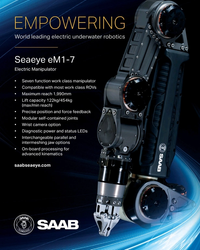 )
March 2024 - Marine Technology Reporter page: 3
)
March 2024 - Marine Technology Reporter page: 3EMPOWERING World leading electric underwater robotics Seaeye eM1-7 Electric Manipulator • Seven function work class manipulator • Compatible with most work class ROVs • Maximum reach 1,990mm • Lift capacity 122kg/454kg (max/min reach) • Precise position and force feedback • Modular self-contained
-
 )
March 2024 - Marine Technology Reporter page: 2
)
March 2024 - Marine Technology Reporter page: 2March/April 2024 On the Cover Volume 67 • Number 3 Image courtesy NIWA-Nippon Foundation TESMaP / Rebekah Parsons-King 8 Subsea Defense Black Sea Mines When the shooting stops in the Ukraine, the tough work of clearing mines will commence. By David Strachan 12 Gliders Slocum Sentinel 22 Teledyne
-
 )
April 2024 - Maritime Reporter and Engineering News page: 43
)
April 2024 - Maritime Reporter and Engineering News page: 43“The industry is an ecosystem which includes owners, managers, mariners, shipyards, equipment makers, designers, research institutes and class societies: all of them are crucial,” – Eero Lehtovaara, Head of Regulatory & Public Affairs, ABB Marine & Ports All images courtesy ABB Marine and Ports provi
-
 )
April 2024 - Maritime Reporter and Engineering News page: 41
)
April 2024 - Maritime Reporter and Engineering News page: 41Nautel provides innovative, industry-leading solutions speci? cally designed for use in harsh maritime environments: • GMDSS/NAVTEX/NAVDAT coastal surveillance and transmission systems • Offshore NDB non-directional radio beacon systems for oil platform, support vessel & wind farm applications
-
 )
April 2024 - Maritime Reporter and Engineering News page: 25
)
April 2024 - Maritime Reporter and Engineering News page: 25RADM PHILIP SOBECK, MILITARY SEALIFT COMMAND Photo by Brian Suriani USN Military Sealift Command From a global supply chain perspective, What makes MSC so vital to the we’ve learned a lot about dealing with Navy’s ? eet and our military disruptions. COVID delivered a big forces around the world? wake-up
-
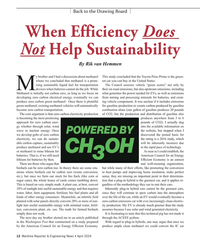 )
April 2024 - Maritime Reporter and Engineering News page: 12
)
April 2024 - Maritime Reporter and Engineering News page: 12Back to the Drawing Board When Efficiency Does Not Help Sustainability By Rik van Hemmen y brother and I had a discussion about methanol This study concluded that the Toyota Prius Prime is the green- where we concluded that methanol is a prom- est car you can buy in the United States. ising sustainable
-
 )
April 2024 - Maritime Reporter and Engineering News page: 10
)
April 2024 - Maritime Reporter and Engineering News page: 10Maritime Safety © Roman/AdobeStock SIRE 2.0: Navigating the New Horizon of Maritime Safety By Captain Aaron Cooper, Programs Director, OCIMF he maritime industry is on the cusp of a signi? cant preparing vessel operators and vessel assurance teams for the transformation with the launch of the Ship
-
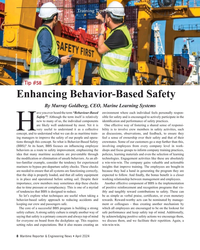 )
April 2024 - Maritime Reporter and Engineering News page: 8
)
April 2024 - Maritime Reporter and Engineering News page: 8Training Tips for Ships © By tuastockphoto/AdobeStock Tip #58 Enhancing Behavior-Based Safety By Murray Goldberg, CEO, Marine Learning Systems ave you ever heard the term “Behaviour-Based environment where each individual feels personally respon- Safety”? Although the term itself is relatively sible for
-
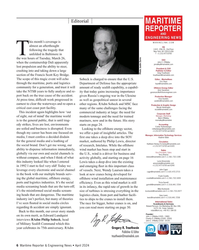 )
April 2024 - Maritime Reporter and Engineering News page: 6
)
April 2024 - Maritime Reporter and Engineering News page: 6Editorial MARITIME REPORTER AND ENGINEERING NEWS his month’s coverage is M A R I N E L I N K . C O M almost an afterthought HQ 118 E. 25th St., 2nd Floor following the tragedy that New York, NY 10010 USA T +1.212.477.6700 Tunfolded in Baltimore in the wee hours of Tuesday, March 26, CEO John C.
-
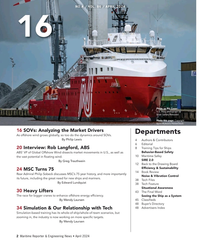 )
April 2024 - Maritime Reporter and Engineering News page: 2
)
April 2024 - Maritime Reporter and Engineering News page: 2NO.4 / VOL. 86 / APRIL 2024 16 Photo on the Cover: U.S. Navy photograph by Brian Suriani/Released Photo this page: Copyright Björn Wylezich/AdobeStock 16 SOVs: Analyzing the Market Drivers Departments As offshore wind grows globally, so too do the dynamics around SOVs. By Philip Lewis 4 Authors & Contribut
-
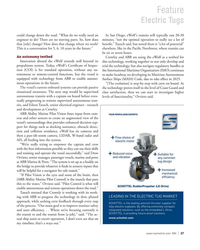 )
April 2024 - Marine News page: 37
)
April 2024 - Marine News page: 37Feature Electric Tugs could change down the road. “What do we really need an In San Diego, eWolf’s transits will typically run 20-30 engineer to do? There are no moving parts. So, how does minutes, “not the optimal operation to really see a lot of that [role] change? How does that change where we work?
-
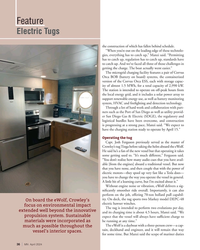 )
April 2024 - Marine News page: 36
)
April 2024 - Marine News page: 36Feature Electric Tugs the construction of which has fallen behind schedule. “When you’re out on the leading edge of these technolo- gies, everything has to catch up,” Manzi said. “Permitting has to catch up, regulation has to catch up, standards have to catch up. And we’ve faced all three of those challenge
-
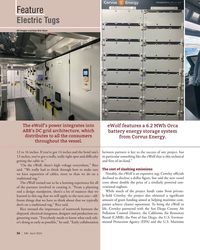 )
April 2024 - Marine News page: 34
)
April 2024 - Marine News page: 34Feature Electric Tugs All images courtesy Eric Haun The eWolf’s power integrates into eWolf features a 6.2 MWh Orca ABB’s DC grid architecture, which battery energy storage system distributes to all the consumers from Corvus Energy. throughout the vessel. 12 to 16 inches. If you’ve got 14 inches and
-
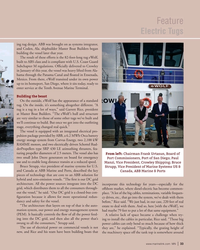 )
April 2024 - Marine News page: 33
)
April 2024 - Marine News page: 33Feature Electric Tugs ing tug design. ABB was brought on as systems integrator, and Coden, Ala. shipbuilder Master Boat Builders began building the vessel later that year. The result of these efforts is the 82-foot-long tug eWolf, built to ABS class and is compliant with U.S. Coast Guard Subchapter M
